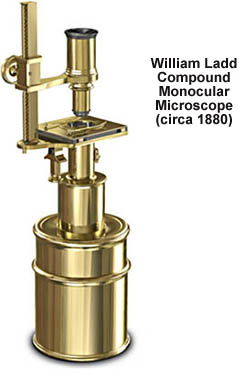William Ladd Compound Monocular Microscope
This unusual multi-cylinder microscope was designed and built by British instrument maker William Ladd in 1880. At the very bottom of the largest cylinder is a glass plate that is over three inches in diameter. The purpose of the plate is to allow light to enter thorough the bottom of the microscope to illuminate the specimen.

Attached to the upper (and smallest) cylinder is a stationary stage plate, which sandwiches a movable stage plate with a small aperture. At the rear of the stage plate is a triangular rod that acts as the limb of the microscope to which the lens holder is attached. Focusing is achieved through a steel chain that is moved by means of a knurled knob positioned on the collar that holds the lens. The specimen is secured to the stage by means of two spring clip holders.
BACK TO NINETEENTH CENTURY MICROSCOPES
